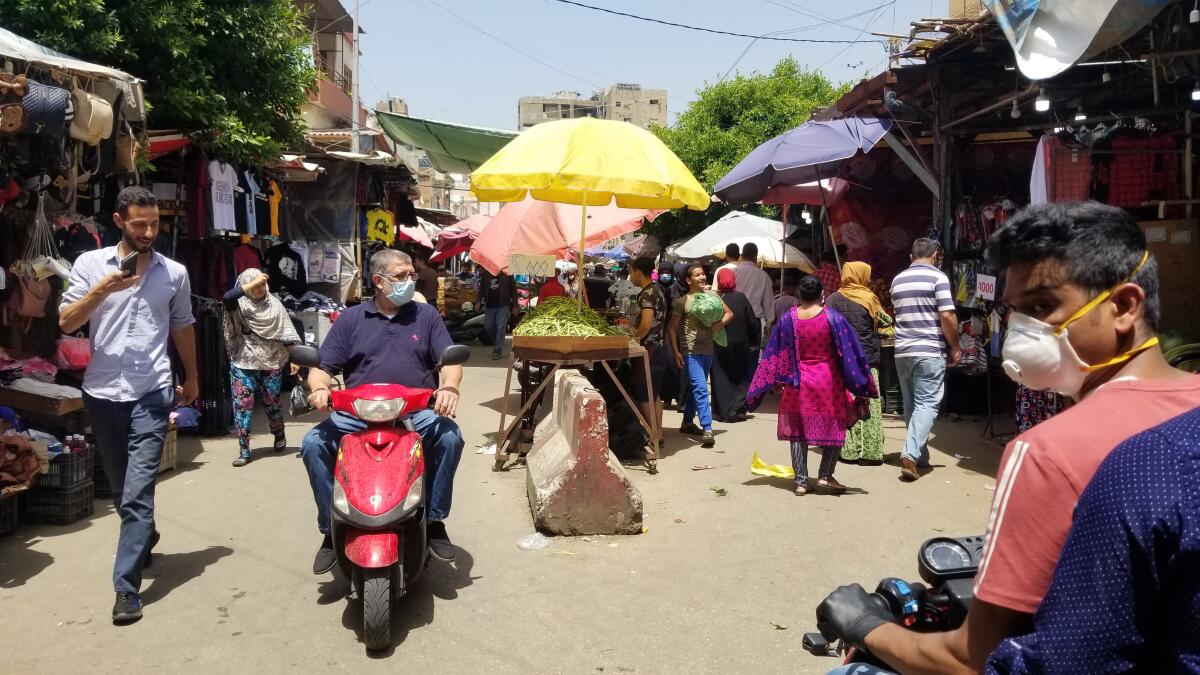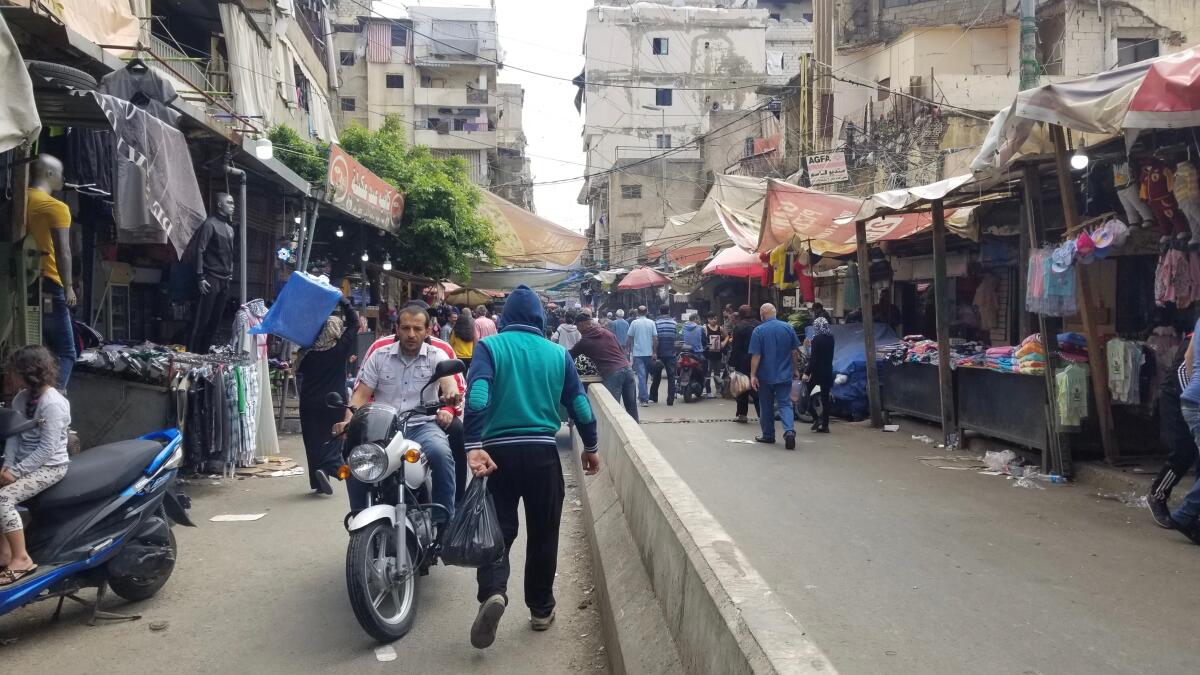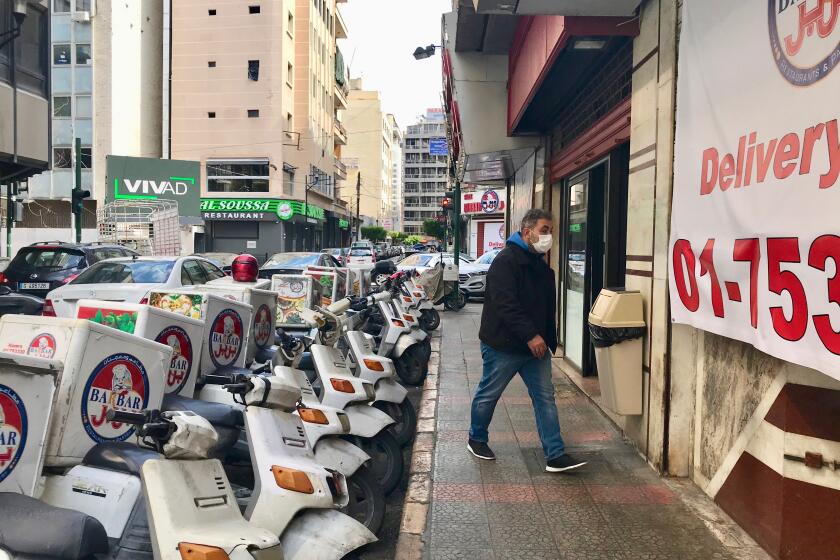No stranger to threats, refugees now face an invisible one: Coronavirus

BEIRUT — Stroll along Sabra Street and you enter a time before COVID-19 and quarantines.
The open-air market running its half-mile length is a scrum of hollering merchants, dilapidated cars and scooters swerving around pedestrians and gaping potholes. The road dribbles into the nearby Shatila camp for Palestinian refugees, where restaurants, sidewalk water pipe joints, barbers, garages are all open, even crowded, in what feels these days like an almost obscene display of social proximity.
But it’s less a matter of indifference to the coronavirus than desperation, said Ali Fayyadh, security head for the Palestine Liberation Organization, one of several factions that administer Shatila.
“We’re already immune to corona. Thank God we have sewage and trash all over the place,” he said, grimacing as he skipped over a pool of dank water.
“Even if they threw a biochemical weapon on us, we’d be fine.”
Near him stood Omar, a guard adjusting the strap of his Kalashnikov over his shorts and fanny pack.
“Yeah, corona probably came to the camp, saw how it is here and turned right around,” he said.
Almost three months after Lebanon recorded its first case, the government here has won kudos for keeping down the numbers of infected; its tally now stands at 886 cases and 26 deaths in a country of 6.8 million people. But as it balances the need to reopen with fears of a second wave of infections, refugee communities like Shatila — overcrowded, under-serviced and often ignored by the state — have emerged as the weak link, officials, health providers and aid groups say.
“The fear is from what will come in the future, because if — God forbid — the epidemic spreads in the camps, we’ll have a huge problem,” Hasan Mneimneh, a former Cabinet minister and head of the Lebanese-Palestinian dialogue committee, said in a phone interview.
Lebanon, a tiny Mediterranean nation that endured a civil war between 1975 and 1990, has some 1.5 million Palestinian and Syrian refugees, making it the country with the largest number of refugees per capita in the world.
Across the globe, there are more than 70 million people who have been forced to leave their homes because of various conflicts; an estimated 10 million are jammed into camps and other settlements where healthcare is scarce and conditions are rife for the spread of diseases like COVID-19. Advocacy groups fear the onset of an undetected coronavirus crisis.

One of the largest groupings in Lebanon is in Shatila camp — established in 1949, one year after the creation of Israel — and the adjoining neighborhood of Sabra, which are squeezed together into about a quarter of a square mile astride a major highway in south Beirut.
It’s not the first time the camp’s residents have faced danger. During Lebanon’s civil war, Sabra and Shatila were the site of a 1982 massacre by Israeli-backed Christian Falangist militias, who slaughtered hundreds, possibly thousands, of Palestinians — men, women, children, even babies — in a bloodbath noted for its barbarity in a conflict that never lacked it.
Despite the violence, there are still Palestinians here. But the area has also become home to other refugees, political as well as economic: Syrians, Moroccans, Yemenis, Sri Lankans, Bangladeshis, Egyptians, even poorer Lebanese, who have settled in recent years in cheaper but cramped dwellings, swelling the population to more than 30,000, camp administrators and government officials say.
In the COVID-19 outbreak, Sabra and Shatila face a different threat from war, but the pathogen could prove grimly destructive.
The United Nations Relief and Works Agency for Palestinian refugees and medical aid groups reported one infection last month in the Jalil camp in Lebanon’s Bekaa Valley. No other confirmed cases have surfaced among the hundreds of refugee communities, including Sabra and Shatila.
But testing is minimal to nonexistent. The Lebanese government has conducted more than 56,000 tests nationwide, at a rate of about 1,000 a day, but it has run only 400 among Palestinian refugees, 16 of them in Shatila, according to UNRWA figures. Though testing and treatment for COVID-19 is free for individuals approved by the Ministry of Public Health, the government leaves it to cash-strapped UNRWA and the U.N. high commissioner for refugees to pay healthcare costs for Palestinian and Syrian refugees and provide them with hygiene items as well as protective equipment.
The camps could be fertile ground for the disease. Families of 10 cram into one-room apartments. Lack of sanitation is evident everywhere; garbage and grime spackle almost every surface. Electricity wires dangle near water pipes laid above sludge-filled alleyways (deaths by electrocution have happened in the past).
“We were doing sterilization drives every day for a while,” said Kathem Hassan, the PLO’s secretary in Shatila. When the bottles of disinfectant ran out, workers used water with a bit of chlorine, he said.
“It’s useless anyway. What you’re disinfecting would in the first place be counted under health guidelines as a trash heap,” he said.
The dismal conditions here and in other refugee settlements throughout Lebanon predate the coronavirus outbreak, an outcome of a long-standing Lebanese government policy to treat the camps as temporary and discourage refugees from staying. Palestinians, and to a lesser extent Syrians, also face restrictions in access to healthcare services, social assistance programs and jobs.
At the same time, municipalities across the country have imposed harsher measures on refugees than those placed on Lebanese, including longer curfews and no-exception lockdowns. Top Lebanese politicians have called for the camps to be fully isolated.
COVID-19 is only the most recent in a series of calamities grinding down Lebanon. A nationwide shortage of dollars since September has pushed the Lebanese currency to less than a third of its previous value and prompted anti-government protests that brought more than a million people to the streets. Thousands of businesses were shuttered. Almost half the population is expected to fall below the poverty line this year, the World Bank said, even without the coronavirus outbreak.
You can deal with militias and armies, the owners of Beirut’s famous Barbar restaurant say, but you can’t make friends with the coronavirus.
“Day to day, people in Lebanon are afraid to go into the supermarket because of the prices they’ll see. And the impact on refugees is tripled, quadrupled,” said Huda Samra, UNRWA’s communication advisor, in a phone interview.
Aid groups have rallied to contain the damage, but assistance has been stalked by shortfalls.
UNRWA has struggled to maintain funding since the Trump administration withdrew support in 2018. It launched several funding appeals to provide cash assistance — a one-time payment of $90 — to families but didn’t get enough donations, Samra said.
“We reached a point where we couldn’t wait any longer. Things were reaching the level of human disaster, so we had to pull from internal funds to give out emergency help,” she said. Finally, instead of $90, the agency gave families 100,000 Lebanese pounds — less than $25.
“People have no idea how they are going to be able to provide for their families. In March, we asked Syrian refugees what were their top priorities, and 32% told us they were in critical need of food,” Matias Meier, country director for the International Rescue Committee, said by phone. That figure reached 92% this week, he said.
It’s easy to glimpse that desperation at the open-air market in Sabra, where merchants ply their goods regardless of the risks of coronavirus transmission.
“Business? It’s not even a quarter of what we normally get,” said Mohammad Deerawi, a butcher whose prices for meat had more than doubled since September. “When they do come, customers get a pound. Before, they would have gotten 3 at least.”
In one grocery store, a trickle of customers approached Ibrahim Mohammad, a slender 18-year-old clerk, to inquire about the price of an item, only to whistle and walk away once they heard the answer.
“There’s nothing I can do. There’s no point in working anymore,” he said. “Every time I sell something, its price ends up increasing and it becomes a loss for me.”
Nearby was a photo studio belonging to Ahmad Qassem, a Palestinian refugee who has lived for decades with his wife and five children in an apartment near Shatila. His two sons, he said, had to stop working as deliverymen while he scrambled to get more work. His money is stuck in Lebanese banks that since September have limited withdrawals.
The studio used to bring in more than $50 a day. “This is a big store. From the time of corona till now, I barely get more than a dollar a day,” he said.
“It’s never been so bad here. We don’t know what to do.”
More to Read
Sign up for Essential California
The most important California stories and recommendations in your inbox every morning.
You may occasionally receive promotional content from the Los Angeles Times.












